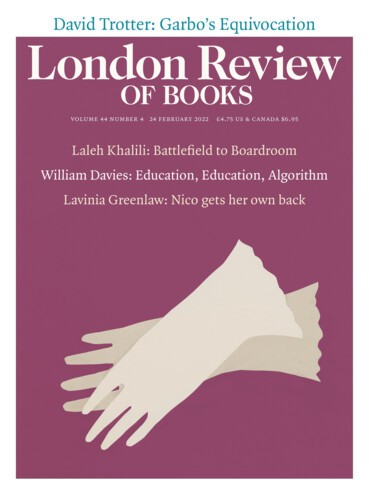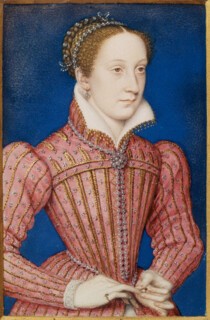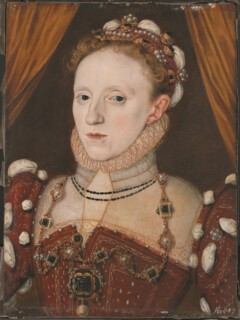Choosing a husband for Elizabeth I was always going to be tricky, but in 1560 the diplomat Nicholas Throckmorton announced that he’d figured it out. Throckmorton’s choice would strengthen Elizabeth’s claim to the throne, unite the island of Britain and guarantee peace with France. His candidate was intelligent (if not quite as scholarly as Elizabeth), above average height (at five foot eleven), well educated, attractive, good humoured, age appropriate, healthy and athletic, and shared Elizabeth’s interests in music, dancing, hawking and riding. Throckmorton could hardly do better. The only requisite would be a sex change, for either Elizabeth or Mary, Queen of Scots, Throckmorton didn’t mind which. ‘Methinks it were to be wished of all wise men and Her Majesty’s good subjects,’ he wrote to Robert Dudley, ‘that one of these two queens of the isle of Britain were transformed into the shape of a man, to make so happy a marriage, as thereby there might be a unity of the whole isle.’
Elizabeth and Mary: Royal Cousins, Rival Queens at the British Library (until 20 February) is ‘the first major exhibition to consider these two iconic female rulers together’, according to its curator, Andrea Clarke. Elizabeth and Mary were obsessed with each other. Mary was the great-granddaughter of Henry VII; her paternal grandmother was Henry VIII’s older sister, Margaret Tudor. While most of Europe thought of Elizabeth as a bastard – how could a daughter of Anne Boleyn be otherwise? – Mary was as legitimate as they come. Henry VIII had removed Elizabeth from the line of succession, and only an Act of Parliament had returned her to it. When Mary was a teenager, married to the French dauphin, Henry II of France declared her not only queen of Scots (as she had been since the death of her father, James V, when she was six days old), but queen of England and Ireland too. The show includes a sketch of Mary’s ‘false arms’ – French, Scottish and English arms displayed together on a single shield – that Throckmorton sent from France to Elizabeth’s chief adviser, William Cecil. When the English complained about Mary’s ‘injurious pretensions’, the French backtracked, and claimed that ‘the bearing of the English arms’ had been ‘done for the honour of Elizabeth’ – i.e. Mary was proud of their cousinship. No one was fooled.
The first section of Elizabeth and Mary offers up their parallel lives via a parade of treasure: Anne Boleyn’s letter from Greenwich Palace announcing Elizabeth’s birth (preprinted, it too optimistically celebrated the ‘deliverance and bringing forth of a prince’, so a single ‘s’ was squeezed in at the end); Elizabeth’s mother-of-pearl locket ring (usually at Chequers); her girlhood translations of English prayers into Latin, Italian and French. While Mary Tudor, her Catholic half-sister, was queen, Elizabeth observed Mass, kept her head down and bided her time. On loan from the National Archives is the letter she sent to the queen following a failed Protestant rebellion. Elizabeth wrote it from Whitehall, very slowly, holding everyone up, waiting for the tide on the Thames to turn: she knew that when the water rose, boats wouldn’t be able to pass under London Bridge, so no one would be able to take her to the Tower that day. Elizabeth writes that she has been her sister’s most loyal subject ‘from the beginning, and will be to my end’; she sensibly scores out blank spaces, to prevent anyone from adding a forged confession in her name. She is prudent, and vulnerable, and the show emphasises that she remained so, even on the throne. There were always rumours that Spanish troops were about to land in Sussex or Cumbria, or invade through Wales, with assistance from the pope or the king of France, or sometimes the dukes of Guise and Parma. Her advisers warned her that English Catholics had never stopped plotting to put another queen in her place.
On Mary’s side – the show delivers on its promise of ‘equal billing’ – there’s a copy of the Treaty of Greenwich, which agreed that the Queen of Scots, still a baby, would eventually marry Henry VIII’s son, Edward. Had Edward lived, and the union between England and Scotland held, she would have become queen of England, Elizabeth’s ‘sister’. Instead, Scotland turned to France, and Mary was betrothed to the dauphin. Her portrait from c.1558, on loan from the Royal Collection, shows a self-assured young woman putting a ring on the fourth finger of her right hand: an allusion to her marriage, but also to her assumption of authority (over how many realms was open to question). In the reports of the Venetian ambassador, Mary is wilful and impulsive; in Throckmorton’s reports back to England, she is smarter and more capable. Sometimes Throckmorton lays it on thick: when he wants to rebuke Elizabeth for not deferring to her counsellors, he overpraises her cousin, who ‘thinketh herself not too wise, but is content to be ruled by good counsel and wise men (which is a great virtue in a prince or princess, and which argueth a great judgment and wisdom in her)’.
Mary was queen of France for seventeen months. Then her husband died, and Mary, aged seventeen, was left without a place at the French court. She wrote that Elizabeth, who had acceded to the English throne two years earlier, was now her nearest ‘kinswoman’ and asked her for a promise of safe conduct for her return to Scotland, via Dover. Elizabeth was slow to grant it; Mary was sure that if only they could meet in person, they would ‘satisfy each other much better than they can do by messages and ministers’. They exchanged portraits, a kind of flirtation. Mary sent Elizabeth verses; Elizabeth sent her a ring, which the diplomat Thomas Randolph said was ‘marvellously esteemed, oftentimes looked upon, and many times kissed’. To see Elizabeth’s face, Mary told Randolph, ‘is the thing that I have most desired ever since I was in hope thereof’. The show includes a memorandum Cecil wrote weighing ‘pro and contra’ of such a meeting in 1562. Pro was the ‘earnest desire of both queens to meet’. Contra was the situation in France: Mary’s relatives were killing Huguenots. He also worried that Elizabeth would grant Mary’s request to be named the ‘second person in the realm’, despite her Catholicism. Elizabeth was in no rush to name anyone her successor, however. To do so, she told the Scottish ambassador, would diminish her own popularity: ‘I know the inconstancy of the people of England, how they ever mislike the present government and have their eyes fixed upon the person who is next to succeed.’ But Cecil didn’t trust her not to do it eventually. And he suspected she might actually believe in the divine right of kings, meaning that when it came to it, she would privilege Mary’s hereditary right to the crown over any practical implications for Protestants. If it were up to Cecil – and often it was – the two queens would never meet.
It all went downhill from there, of course. Elizabeth let it be known, through her ambassador, that she ‘misliked’ Mary’s proposed marriage to their cousin Henry Stuart, Lord Darnley, which went through nonetheless. Darnley had his own claim to the English throne, strengthening Mary’s, and the couple became even more attractive, dynastically speaking, after the birth of their son. Elizabeth was 32 when Mary named her godmother to the future James VI (over Darnley’s objections) and didn’t take it well: ‘Alack, the Queen of Scots is lighter of a bonny son, and I am but of barren stock.’ On display at the BL is Elizabeth’s New Year’s gift-roll for 1567: she sent her godson a humongous gold font, but didn’t attend his baptism. Two months later, Darnley’s dead body – strangled, though ‘not a hurt nor a mark’ on him – was discovered in a garden near Kirk o’ Field. (Whodunit? The record is a mess and historians mostly admit defeat.) Elizabeth sent Mary a letter. She offers her condolences, but also, as a ‘faithful cousin’ and ‘affectionate friend’, tells Mary she had better watch out: ‘I will not conceal from you that people for the most part are saying that you will look through your fingers at this deed instead of avenging it.’ Placards erected in Edinburgh (one is in the show) were insinuating that the chief suspect in Darnley’s murder, the Earl of Bothwell, had been Mary’s lover. Elizabeth advised Mary to ‘preserve her honour’ by bringing charges against Bothwell: ‘I exhort you, I counsel you, and I beg you to take this thing so far to heart that you will not fear to touch even him whom you have nearest to you if he was involved.’ Instead, three months after Darnley’s murder, Mary and Bothwell were married. The Scottish lords revolted and Mary was forced to abdicate in favour of her one-year-old son. Bothwell fled to Scandinavia. Mary went south – she thought to safety.
The British Library has the letter Mary wrote to Elizabeth from Workington in Cumberland. She was ‘in pitiable condition, not only for a queen, but for a gentlewoman’, though with every ‘confidence’ that her ‘sister’ would not only assure ‘the safety of my life’ but ‘also to aid and assist me in my just quarrel’ – that is, to put her back on the Scottish throne. At first Elizabeth took Mary’s side. Mary had been too easily toppled – it set a bad precedent. The show has another Cecil memorandum, pro and contra. He still believed Mary to be dangerous. It would be best for England if she were to ‘live in some convenient place without possessing of her kingdom, where she may not move any new troubles’ – ideally, an English prison, far from the coast. Her trial for complicity in Darnley’s murder, which Elizabeth authorised, was ostensibly a ‘conference’ between Mary and the Scottish lords who were calling for her head. The verdict was inconclusive, but provided pretext enough to keep her locked up. Mary’s letters to Elizabeth are hurt, confused, indignant – she asked ‘what you would do in my place’. She wrote to Elizabeth (in her best handwriting) that she was her ‘cousin, the closest you have in the world’, and she didn’t understand why Elizabeth had ‘disdained’ to answer her letters, only ‘treating me worse and worse’. She kept petitioning for an audience, in order to ‘unburden my heart to you, rendering myself all yours’, but though the two queens are always meeting in Schiller and Donizetti, to say nothing of the movies, they never did.
I rushed through the last rooms of the show – there were too many mask-less coughers. The BL has created a virtual version on its website, but I was disappointed not to linger over Mary’s fabulous embroideries (one shows a she-dolphin giving birth – an allusion to herself, the former dauphine?) mounted on green velvet, or the tightly scrawled, heartbroken ten-page letter she wrote to Elizabeth thirteen years into her captivity, begging to leave England: ‘to withdraw myself out of your realm, into some place of repose, to seek some comfort for my poor body, worn out as it is with continual sorrows’. When Elizabeth had been a prisoner, she had been careful not to do anything that might anger her sister, nothing that might arouse suspicion. Not so Mary. Even when she wasn’t scheming – to depose Elizabeth, to escape to Scotland or France, to get Philip II to pay for a naval assault (with a Catholic uprising in Ireland as a diversion) – her insistence on using ciphers and invisible ink, or on sending and receiving clandestine messages (hidden in bales of cloth, book bindings, beer barrels), didn’t do her any favours. The show includes a video demonstration of Mary’s ‘spiral locking’ technique of sealing envelopes, an elaborate sequence of cuts and folds to prevent Elizabeth’s spymaster, Francis Walsingham, from intercepting her letters (he did so anyway). As far as Cecil was concerned, Mary had attempted treason many times over.
After James VI, who had been raised Protestant and pensioned by Elizabeth, signed a peace treaty with England, Cecil saw little reason to keep Mary alive. In Elizabeth’s own working copy of the speech she delivered to Parliament in 1586, in response to the call for Mary’s execution, she imagined a world in which she and Mary weren’t rulers, ‘but as two milkmaids, with pails upon our arms’. She told MPs that she was unable to give a ‘speedy answer’ and asked them to come up with some other solution. It wasn’t that she didn’t want Mary dead, but that she didn’t want to be responsible for killing her: a natural death (she thought that Mary would probably die rather quickly if her conditions were harsher) or an assassination (she asked Mary’s jailer to do it) would be better. She told the French ambassador that she had never shed so many tears as over this ‘unfortunate affair’. She signed Mary’s death warrant, but when she heard that the execution had taken place, claimed she hadn’t given her secretary permission to carry the warrant to the council. The secretary was sent to the Tower for his impudence and Elizabeth wrote to James VI, apologising for the ‘miserable accident’ of his mother’s death. James accepted the explanation, but wrote back that he expected ‘full satisfaction in all respects, as shall be a means to strengthen and unite this isle’. Sixteen years later he got what he wanted.
Send Letters To:
The Editor
London Review of Books,
28 Little Russell Street
London, WC1A 2HN
letters@lrb.co.uk
Please include name, address, and a telephone number.



